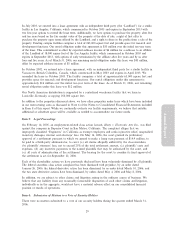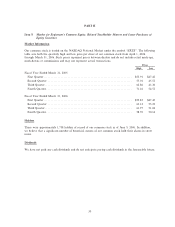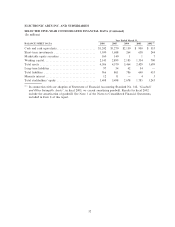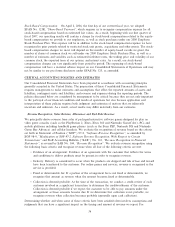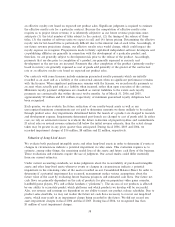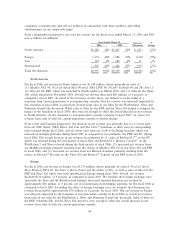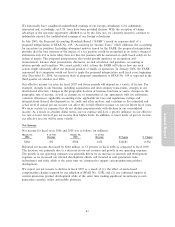Electronic Arts 2006 Annual Report Download - page 111
Download and view the complete annual report
Please find page 111 of the 2006 Electronic Arts annual report below. You can navigate through the pages in the report by either clicking on the pages listed below, or by using the keyword search tool below to find specific information within the annual report.
Income Taxes
In the ordinary course of our business, there are many transactions and calculations where the tax law and
ultimate tax determination is uncertain. As part of the process of preparing our Consolidated Financial
Statements, we are required to estimate our income taxes in each of the jurisdictions in which we operate
prior to the completion and Ñling of tax returns for such periods. This process requires estimating both our
geographic mix of income and our current tax exposures in each jurisdiction where we operate. These
estimates involve complex issues, require extended periods of time to resolve, and require us to make
judgments, such as anticipating the positions that we will take on tax returns prior to our actually
preparing the returns and the outcomes of disputes with tax authorities. We are also required to make
determinations of the need to record deferred tax liabilities and the recoverability of deferred tax assets. A
valuation allowance is established to the extent recovery of deferred tax assets is not likely based on our
estimation of future taxable income in each jurisdiction.
In addition, changes in our business, including acquisitions, changes in our international structure, changes
in the geographic location of business functions, changes in the geographic mix and amount of income, as
well as changes in our agreements with tax authorities, valuation allowances, applicable accounting rules,
applicable tax laws and regulations, rulings and interpretations thereof, developments in tax audit and other
matters, and variations in the estimated and actual level of annual pre-tax income can aÅect the overall
eÅective income tax rate and result in a variance between the projected eÅective tax rate for any quarter
and the Ñnal eÅective tax rate for the Ñscal year.
With respect to our projected annual eÅective income tax rate at the end of each quarter prior to the end
of a Ñscal year, we are required to make a projection of several items, including our projected mix of full-
year income in each jurisdiction in which we operate and the related income tax expense in each
jurisdiction. This projection is inherently uncertain and can Öuctuate throughout the Ñscal year. The
projected annual eÅective income tax rate may also be adjusted for taxes related to certain anticipated
changes in how we do business. SigniÑcant non-recurring charges are taken in the quarter incurred. The
actual results could and often does vary from those projections, and as such, the overall eÅective income
tax rate for a Ñscal year could be diÅerent from that previously projected for the full year.
RESULTS OF OPERATIONS
Our Ñscal year is reported on a 52 or 53-week period that, historically, has ended on the Ñnal Saturday of
March in each year. Beginning with the Ñscal year ended March 31, 2006, we end our Ñscal year on the
Saturday nearest March 31. As a result, Ñscal 2006 contains 53 weeks with the Ñrst quarter containing
14 weeks. Our results of operations for the Ñscal years March 31, 2007, 2006, 2005 and 2004 contain the
Annual Report
following number of weeks:
Fiscal Years Ended Number of Weeks Fiscal Period End Date
March 31, 2007 ÏÏÏÏÏÏÏÏÏÏÏÏÏÏÏÏÏÏÏÏÏÏÏÏÏÏÏÏÏÏÏÏÏÏÏÏÏÏÏÏÏÏÏ 52 weeks March 31, 2007
March 31, 2006 ÏÏÏÏÏÏÏÏÏÏÏÏÏÏÏÏÏÏÏÏÏÏÏÏÏÏÏÏÏÏÏÏÏÏÏÏÏÏÏÏÏÏÏ 53 weeks April 1, 2006
March 31, 2005 ÏÏÏÏÏÏÏÏÏÏÏÏÏÏÏÏÏÏÏÏÏÏÏÏÏÏÏÏÏÏÏÏÏÏÏÏÏÏÏÏÏÏÏ 52 weeks March 26, 2005
March 31, 2004 ÏÏÏÏÏÏÏÏÏÏÏÏÏÏÏÏÏÏÏÏÏÏÏÏÏÏÏÏÏÏÏÏÏÏÏÏÏÏÏÏÏÏÏ 52 weeks March 27, 2004
For simplicity of presentation, all Ñscal periods are treated as ending on a calendar month end.
Comparison of Fiscal 2006 to Fiscal 2005
Net Revenue
We principally derive net revenue from sales of packaged interactive software games designed for play on
video game consoles (such as the PlayStation 2, Xbox, Xbox 360 and Nintendo GameCube), PCs and
mobile platforms which include handheld game players (such as the Sony PSP, Nintendo DS and
Nintendo Game Boy Advance) and cellular handsets. We also derive net revenue from selling services to
some of our online games, programming third-party web sites with our game content, allowing other
39


